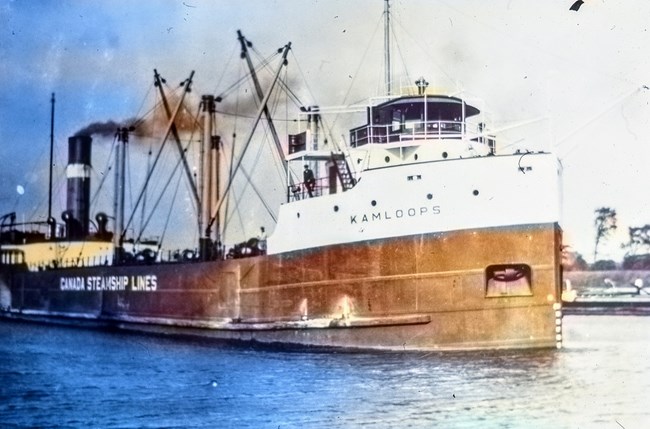Last updated: September 21, 2020
Article
SS Kamloops: Operational History

Donna Dashney Newmark Collection
Operational History
Kamloops' first season on the Lakes started late, when its maiden upbound passage began on September 13, 1924 (Detroit Free Press, Sept. 14, 1924) under Capt. William Brian and engineer T.W. Verity (Great Lakes Red Book, 1925: 51). The new package freighter had arrived from Copenhagen shortly before its sister ship Lethbridge, which reached Montreal on September 18 (Canadian Railway and Marine World, Oct. 1924:527). A cargo of pebbles was brought from Denmark for the Calumet and Hecla Mining Company in Calumet, Michigan. Here the crew which sailed on the maiden voyage was replaced by a crew of Lake sailors (Calumet News, Aug. 24, 1924; Dec 14, 1927). Kamloops passed Port Colborne on the Welland Canal on September 22 downbound for the first time (Detroit Free Press, Sept. 23, 1924).
The first season set the pattern for Kamloops, whose owners continued to operate as long as possible each season. The canaller weathered a severe storm on its last downbound run of the 1924 season on December 13 and 14 when winds of 50 to 60 miles per hour and a temperature of 6° below claimed at least one vessel believed wrecked near Eagle Harbor on the Keewenaw peninsula. After the storm, Kamloops, along with Midland Prince, Midland King and Lethbridge, each with a load of grain, were all reported downbound on Lake Superior, while other vessels were laid up in the shelter of Isle Royale (Marquette Daily Mining Journal, Dec. 15, 1924). The four ships soon became trapped by ice in the St. Mary's River, and two tugs of the Great Lakes Towing Company were dispatched to assist them. Those four vessels were the last of the 1924 season to pass through the locks (Marquette Daily Mining Journal, Dec. 17, 1924).
The 1925 season began for Kamloops in April, when it cleared Sault Ste. Marie on the 20th at 3:30 upbound, and again on the 23rd downbound (Detroit Free Press, April 21, 23, 1925). In October the freighter was held up with 10 others of the grain fleet during a downbound run by the grounding of W. H. Daniels in the Welland canal aqueduct (Detroit Free Press, Oct 12, 1925). The remainder of the season was uneventful.
Kamloops was technically under new ownership the 1926 season. On October 11, Canada Steamship Lines bought the vessel from Steamships, Ltd. On October 28, 1926 the registry listed a mortgage dated October 19, for $50,000,000 (although the amount seems unlikely) loaned at 6 percent yearly interest by Montreal Trust Company.
The first downbound run of the 1926 season began May 3, when Kamloops cleared Detroit at 3:00 am (Detroit Free Press, May 4, 1926). The ship ended its third season like the first - stuck in the ice. This time there were not four ships stuck in the St. Mary's River ice, but more than 100. The 100 ships were caught in the channel near Neebish Island on December 3, the same location where Kamloops had been trapped earlier. That event was the largest ice jam in the history of upper Lakes shipping, according to contemporary references. The soft ice halted all progress of the steamers, and even the powerful tugs made only slow headway through the slush that in places was 12 feet thick. The problem was increased by the fact that there were about 2,000 people aboard the jammed ships, and supplies ran short (Detroit Free Press, Dec. 4, 1926).
In a list of vessels freed from the ice on December 10 that was published in the Detroit Free Press (Dec. 11), Kamloops is not mentioned, and therefore must have been released on the 11th after being trapped in the ice for 9 days. It was Kamloops last voyage of the 1926 season.
